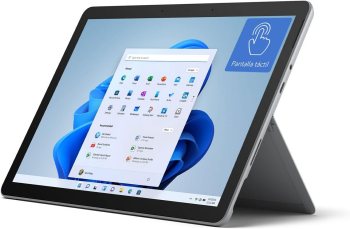- Flexible 360-degree hinge
- Good battery life
- Access to Google Play Store
- High-quality display
- Portable and lightweight
- Good performance
- Long battery life
- Limited offline functionality
- Performance may lag with demanding applications
- Higher price point
- Keyboard sold separately
Lenovo Chromebook Flex 3 vs Microsoft Surface Go 3
When it comes to portable, affordable, and versatile computing devices, two popular options that come to mind are the Lenovo Chromebook Flex 3 and the Microsoft Surface Go 3. Both of these devices can be classified as modern interpretations of traditional netbook laptops, offering a compact form factor and lightweight design that makes them easy to carry around.
The Lenovo Chromebook Flex 3 is a Chrome OS-based device that features an 11.6-inch touchscreen display with a resolution of 1366x768 pixels. It's powered by a MediaTek MT8176C processor, 4GB of RAM, and 64GB of eMMC storage. The device also comes with a 360-degree hinge, allowing it to convert into a tablet mode, making it an excellent option for those who want a single device that can handle both work and play.
On the other hand, the Microsoft Surface Go 3 runs on Windows 11 and features a 10.5-inch PixelSense touchscreen display with a higher resolution of 1920x1280 pixels. It's powered by a more powerful Intel Pentium Gold or Intel Core i3 processor, up to 8GB of RAM, and up to 256GB of SSD storage. The Surface Go 3 also features a kickstand that allows it to be used in various modes, including tablet mode, making it a great option for those who want a device that can handle more demanding tasks.
One key difference between the two devices is their operating systems. The Lenovo Chromebook Flex 3 runs on Chrome OS, which is designed specifically for web-based applications and is ideal for basic tasks such as browsing, email, and streaming. In contrast, the Microsoft Surface Go 3 runs on Windows 11, which offers a more comprehensive set of features and capabilities, including support for desktop applications and more advanced multitasking.
In terms of performance, the Microsoft Surface Go 3 is generally more powerful than the Lenovo Chromebook Flex 3, thanks to its Intel processor and higher RAM options. However, the Chromebook Flex 3 is still capable of handling everyday tasks with ease, and its lower price point makes it an attractive option for those on a budget.
Another significant difference between the two devices is their pricing. The Lenovo Chromebook Flex 3 starts at around $300, while the Microsoft Surface Go 3 starts at around $400. However, the Surface Go 3's higher-end configurations can cost upwards of $700, making it a more expensive option overall.
Ultimately, the choice between the Lenovo Chromebook Flex 3 and the Microsoft Surface Go 3 will depend on your specific needs and preferences. If you're looking for a basic, affordable device that can handle web-based tasks and streaming, the Chromebook Flex 3 may be the better option. However, if you need a more powerful device that can handle desktop applications and more advanced tasks, the Surface Go 3 is likely the better choice.
It's worth noting that both of these devices are part of a new generation of netbook laptops that offer a unique blend of portability, affordability, and versatility. Unlike traditional netbooks, which were often underpowered and limited in their capabilities, modern devices like the Lenovo Chromebook Flex 3 and the Microsoft Surface Go 3 offer a more comprehensive set of features and capabilities, making them ideal for a wide range of users, from students and professionals to travelers and entertainment seekers.































